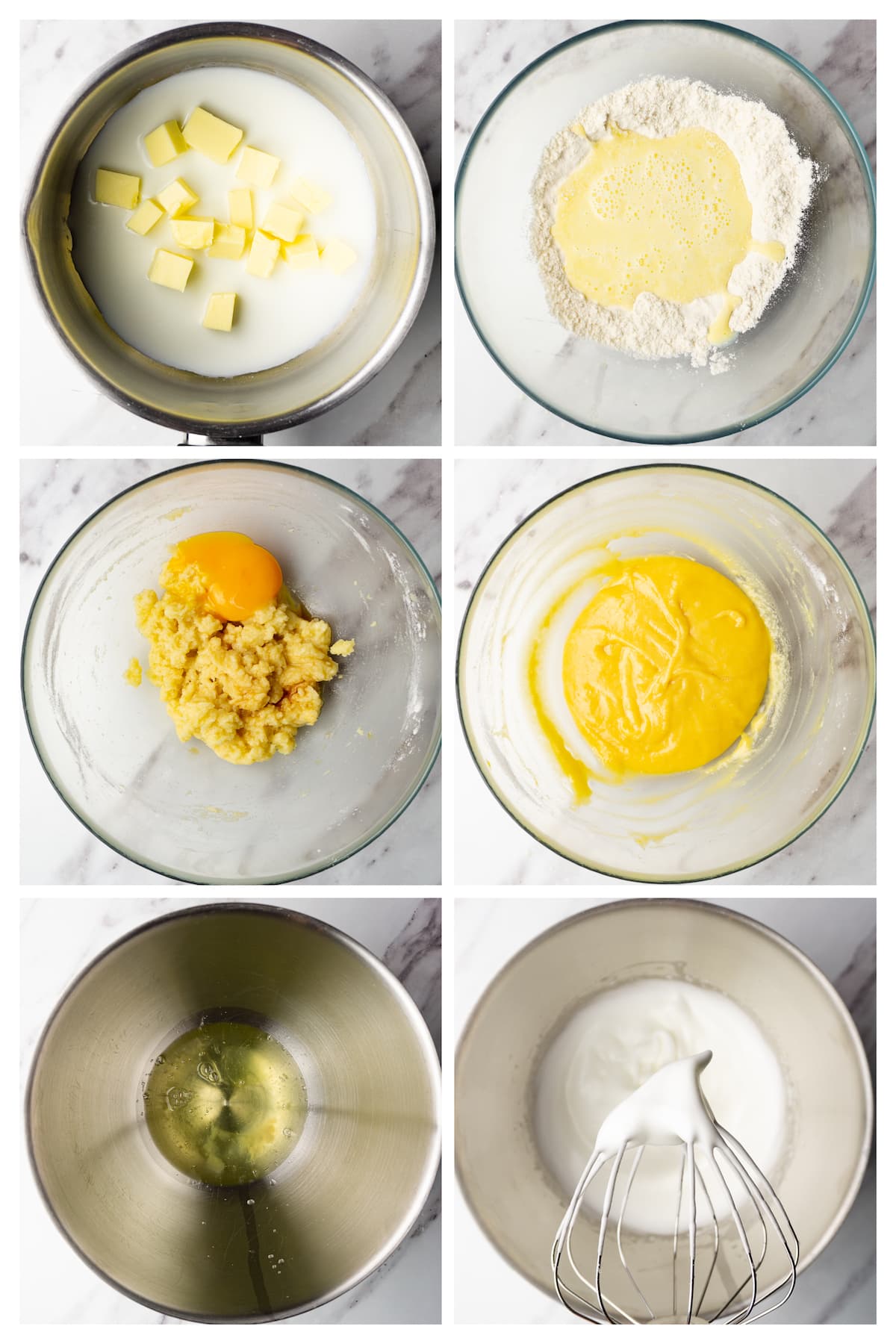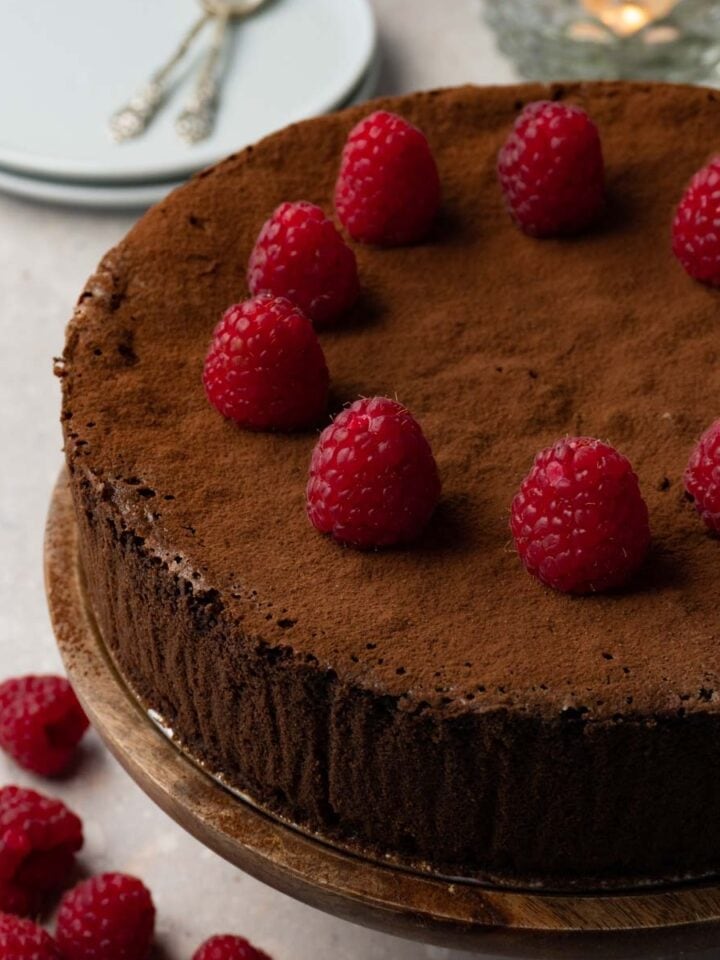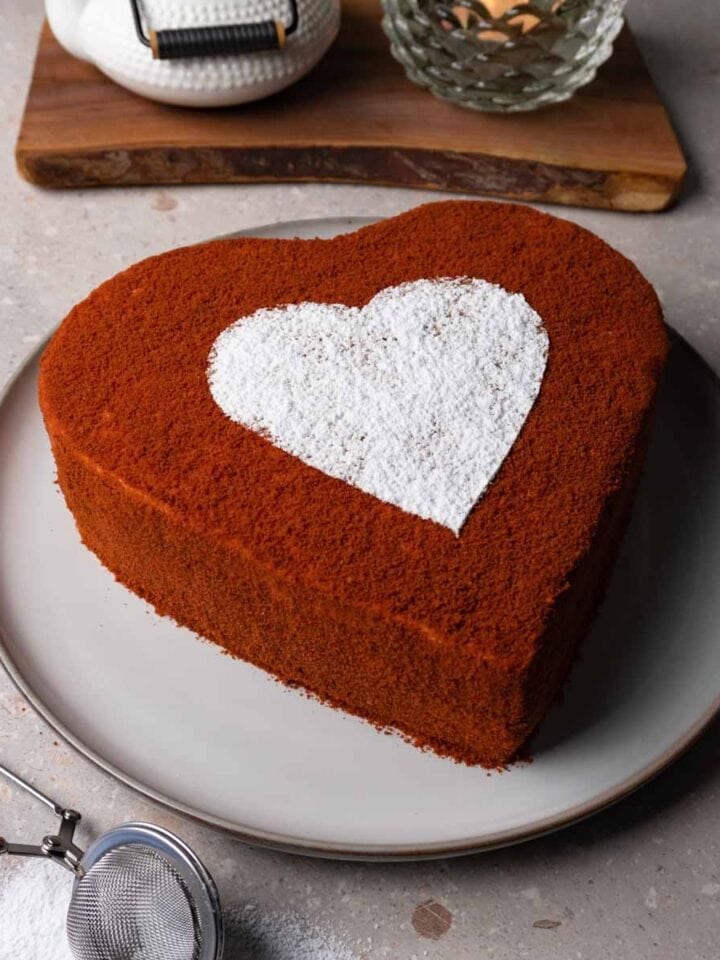Soft like a cloud, this castella cake is a delicious and moist sponge cake you can make at home. Serve it on its own or with whipped cream and fresh berries, chocolate ganache, or any jam or sauce of your choice.

What is castella cake?
Castella cake is a traditional Japanese sponge cake made with simple ingredients such as sugar, eggs, flour, and butter. Some versions include honey, milk, and different flavorings.
The unique texture of this cake comes from the process of whipping the eggs and sugar together until they become thick and fluffy, which creates tiny air pockets in the batter. When the cake is baked, the air pockets expand and give the cake its light, airy texture.
Castella cake is very popular in Taiwan (Taiwanese castella cake is usually made with milk) and other parts of Asia. You can often find it in specialty bakeries and cafes that serve Taiwanese or Japanese sweets.
Ingredients you will need
Flour – I use all-purpose flour to create this castella cake recipe, but if you want a really luxurious sponge cake, go for cake flour.
Eggs – Use large eggs at room temperature. Make sure that when you separate them you don’t contaminate the egg whites with egg yolks or you won’t be able to whip them to create a thick meringue.
Salt and sugar – I use white granulated sugar to whip up with the egg whites and a pinch of salt for flavor.
Lemon juice – It helps to create a more stable meringue which will help you succeed with this recipe from the first try. You can replace lemon juice with ¼ teaspoon of cream of tartar.
Milk – You can use whole milk right from the fridge since we’re going to heat it with butter on the stove anyway.
Butter – Use unsalted butter. As with the milk, it can be right from the fridge. The butter provides not only moisture to our Japanese castella cake but also adds a lot of flavor.
Vanilla extract – This cake is often enjoyed on its own, so I like to add some flavor to it. You can use whatever extract or essence you prefer. Bitter almond or lemon flavorings will fit this cake perfectly.

Cooking tips
- Sift the flour. Sift the flour before mixing it with the other ingredients to ensure that there are no lumps and that the batter will be smooth and airy.
- Use room-temperature eggs. Letting the eggs come to room temperature before using them will help them to whip up better and create more volume in the cake. It’s absolutely not true that cold egg whites whip better!
- Use a gentle folding technique. When adding the flour and egg yolk mixture to the whipped egg whites, use gentle folding movements to avoid deflating the batter. I like to use a rubber spatula to combine the two mixtures, but you can use a large balloon metal whisk instead.
- Bake using a water bath. Placing the loaf pan in a water bath while baking will help the cake to cook evenly and prevent it from cracking.
- Do not open the oven too early. Wait at least 45 minutes to check on your cake. If you open the oven too early, the cake can sink.
- Let the cake cool completely. Castella cake is best served at room temperature, so make sure to let it cool completely before slicing and serving.
How to make castella cake
Make the egg yolk base batter
- Preheat your oven to 150°C (300°F) and line an 8" by 5" (20cm by 13cm) loaf pan with parchment paper.
- In a bowl, sift the flour and salt.
- In a saucepan, heat the milk and butter until the butter has melted and the mixture just starts simmering. Pour the mixture into the bowl with dry ingredients and whisk until smooth and homogenous in consistency.
- Add egg yolks one at a time and vanilla extract, then whisk until well incorporated.

Make the meringue
- In the bowl of a stand mixer fitted with a whisk attachment, add the egg whites and lemon juice. Whip on medium-low until the mixture is foamy. Then, gradually add the sugar while whipping.
- When all sugar is in, switch the speed to medium-high and whip to medium peaks.
Make the castella cake batter
- When done, fold ⅓ of the egg white mixture into the egg yolk mixture until well combined.
- Pour the egg yolk mixture into the rest of the egg whites and gently fold using a rubber spatula.

Bake the cake in the water bath
- Pour the mixture into the prepared loaf pan and tap it a couple of times against a flat surface to force the large air bubbles out.
- Place the pan in a larger baking dish and transfer the construction into the oven. Pour hot water into the baking dish, close the oven, and bake the cake for 45-50 minutes.
- Remove from the oven and let it rest in the pan for 10 minutes. Then, pull out by holding the parchment paper ends and place on a flat surface to cool down completely before serving.
Troubleshooting
- The cake didn’t rise as it should. You probably overmixed your cake batter and deflated it to the point that there weren’t enough air bubbles to lift your cake during baking. Castella sponge cake is much like Genoise sponge cake – no baking powder or baking soda and both rely on air from the whipped eggs. If you deflate your batter during the last mixing stage, it might not rise high in the oven and the cake will turn out flat and dense.
- The cake has a cracked top. This could be due to baking the cake at too high a temperature or not using a water bath. Make sure to follow the recipe carefully and bake the cake at the correct temperature. Also, place the cake mold in a water bath while baking to prevent it from cracking. Having said that, all ovens bake differently and my 150C may be your 160C, which means that you need to get to know your oven and adjust accordingly.

Possible variations
Infusions. The easiest way to add different flavors to your Japanese sponge cake without changing any proportions in the recipe is to infuse the milk with things like matcha powder, fresh vanilla bean, Earl Grey tea, lavender, etc.
To make an infusion, combine the milk with whatever ingredient you’d like to use for an infusion and heat everything in a saucepan (or in a bowl in a microwave) until the first bubbles form. Then, leave the mixture to cool down on a kitchen counter. Strain the milk into a bowl and weigh it. Add fresh milk, if needed to make the weight equal to the one stated in the recipe. Now you can use this milk with the batter and make your cake. Of course, the strength of the flavor will depend on the chosen ingredient. Matcha and vanilla will be more noticeable in the cake than in Earl Grey.
Add citruses. Another way to make your Castella recipe unique is to add orange, lime, and/or lemon zests.
Chocolate cake. By replacing 10-15% of the flour with Dutch-processed cocoa powder, you can create Chocolate castella cake.
Serving ideas
Most of the time, this sponge is enjoyed on its own because it is very moist and sweet enough. However, you can always serve it with toppings of your choice. Lemon curd, Raspberry coulis, any jam, or freshly whipped cream with fresh fruits and berries will fit this delicate dessert.
You can also bake this cake in a round springform pan, slice it, and assemble a simple multiple-layer cake using sweetened whipped cream, fruits, and berry sauces.

FAQ
Store the completely cooled sponge cake in an air-tight container or wrapped in plastic wrap at room temperature for up to 4 days.
Yes, you can freeze your cake for up to 2 months. Wrap it in plastic wrap and then in a piece of foil before freezing. Thaw in the fridge overnight and then let it warm up at room temperature before serving. However, it is worth noting that freezing a cake can affect its texture and taste, so it may not be as good as a freshly baked cake.
No, once you’ve finished mixing the batter, it should be deposited in a baking pan and baked right away.
No, it doesn't! It has a pleasant vanilla flavor.
More related recipes
Recipe card

Castella cake
Equipment
- Digital kitchen scale
- Rubber spatula
- Stand mixer fitted with a whisk attachment or hand mixer and a large mixing bowl
- 8" by 5" (20cm by 13cm) loaf pan
- Saucepan
- Parchment paper
Ingredients
- 50 g all-purpose flour
- Pinch of salt
- 50 ml milk
- 50 g unsalted butter melted
- 1 teaspoon vanilla extract
- 3 large eggs at room temperature, separated
- ¼ teaspoon lemon juice
- 50 g sugar
Instructions
- Preheat your oven to 150°C (300°F) and line an 8" by 5" (20cm by 13cm) loaf pan with parchment paper. You’ll also need a deep baking dish in which you can place your loaf pan and enough hot water to fill the baking dish 1 inch up (water bath baking method).
- In a bowl, sift the flour and salt. Set aside.
- In a saucepan, heat the milk and butter until the butter has melted and the mixture just starts simmering. Pour the mixture into the bowl with dry ingredients and whisk until smooth and homogenous in consistency.
- Add egg yolks one at a time and vanilla extract, then whisk until well incorporated.
- In the bowl of a stand mixer fitted with a whisk attachment (or use a hand mixer and a bowl), add the egg whites and lemon juice. Whip on medium-low until the mixture is foamy. Then, gradually add the sugar while whipping.
- When all sugar is in, switch the speed to medium-high and whip to medium peaks. Do not overwhip to stiff peaks!
- When done, fold ⅓ of the egg white mixture into the egg yolk mixture until well combined.
- Pour the egg yolk mixture into the rest of the egg whites and gently fold using a rubber spatula.
- Pour the mixture into the prepared loaf pan and tap it a couple of times against a flat surface to force the large air bubbles out.
- Place the pan in a larger baking dish and transfer the construction into the oven. Pour hot water into the baking dish, close the oven, and bake the cake for 45-50 minutes or until the top is golden-brown and springy to the touch. The toothpick inserted into the center should come out clean.
- Remove from the oven and let it rest in the pan for 10 minutes. Then, pull out by holding the parchment paper ends and place on a flat surface to cool down completely before serving.





Sara
This cake turned out amazing! Not too sweet and the texture is so soft and fluffy. Will definitely make it again in the future.
Anna
Thank you for your comment, Sara!